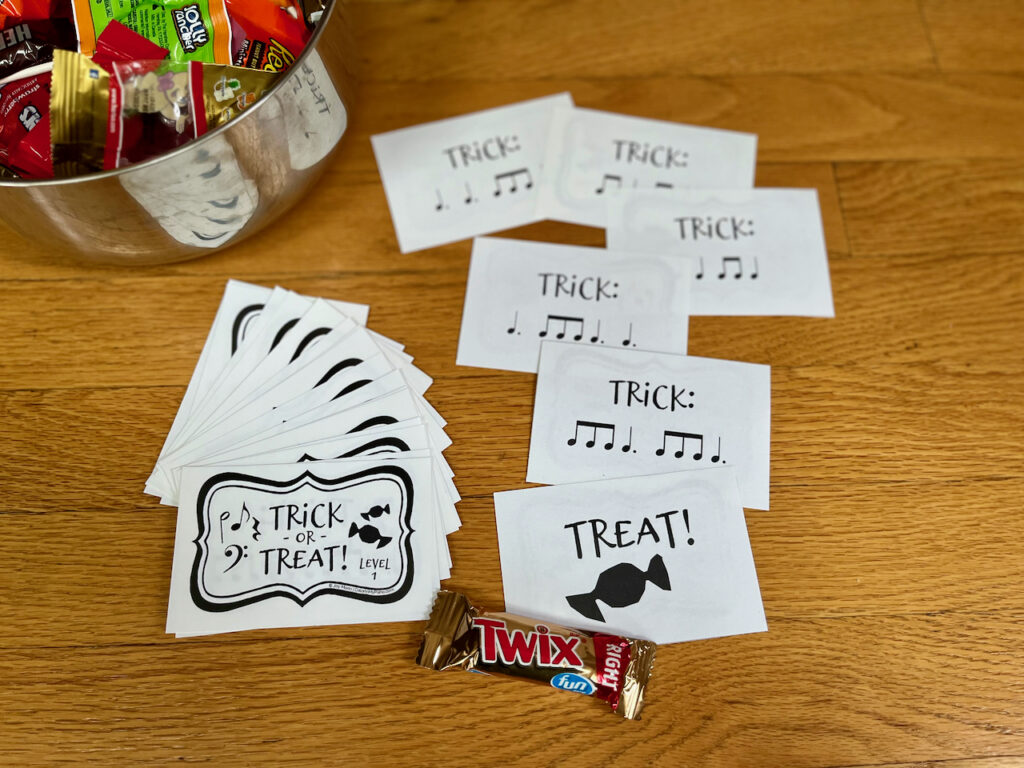
As promised in my last post, today I’m sharing a recent short video of my daughter, Aria, and I playing my Trick-or-Treat rhythm game. In fact, we took this video clip earlier today!
I’ve been playing this game with Aria daily for the past two weeks or so. I don’t ask Aria to read the rhythms on the cards, as I might with my older students. She’s three-and-a-half years of age, and my priorities are on developing her ear and musical understanding of that which she hears (i.e., audiation).
So, instead we use a variation of the game where the teacher reads and performs the rhythm pattern, and the student echoes it back. This is a valuable activity not just for young students, but for any student especially as they encounter new rhythm elements. (Read more about how I use this game with my students here.)
Anyway, please enjoy this short video and my time-stamped notes below. I hope you get some new ideas or inspiration from watching our interaction!
- 0:00 Enjoy Aria’s sense of humor — she tells me she’s not ready to start the game yet because she needs to get her teddy bear set up! Haha.
- 0:19 Aria randomly draws a card. I announce that the rhythm pattern looks to be in Duple Meter (eventually, she’ll recognize it herself, but I model it for now), establish the meter, and then vocally chant the rhythm pattern on a neutral syllable (BAH). Normally, I would use my hands to cue her to breathe on the fourth beat of the rhythm pattern before she echoes it back. I forgot to do it this time, but fortunately she already knows what to do because we’ve been doing music together for awhile now. 🙂 She echoes the pattern back accurately.
- 0:50 Aria draws another card. This rhythm pattern is in Triple Meter this time. Aria echoes the rhythm pattern back accurately other than to add one more note at the end. I have noticed this isn’t an unusual happenstance for students when the rhythm pattern happens to end with lots of activity on the final beat. Especially at this age, it’s not necessary to spend a lot of time making corrections. I simply observe and take mental notes that I can use to inform my teaching going forward.
- 1:15 Aria draws another card, this time in Duple Meter. Aria echoes the rhythm back inaccurately; or stated another way, she gives me a rhythm pattern that isn’t the same. When this happens, usually I just take a mental note and move on. This time, however, I decided to give it another shot and see if she is accurate after hearing it a second time. Again, she performs a rhythm pattern that is not the same as mine.
- 1:45 My assumption is that she is not hearing how my pattern is different from hers. It’s not necessary (or advisable in many cases) to do this with students of her age, but I decide to try to show or model for her how these two patterns are not the same. I ask her to listen to both patterns and to indicate with her hands whether they are the same or different. After she’s heard both patterns, I “give away” the correct answer with my hands. I’m guiding her and teaching her the answers, rather than testing her. In MLT terms, this is called Discrimination or “rote” learning, where we are not yet asking the student to make inferences. There are times when Aria is successful at recognizing when two rhythm patterns are the same or different, but I think these particular rhythm patterns are difficult for her to distinguish between. I know it will come in time when she’s ready. So, we keep the game moving.
- 2:40 Aria draws another card. This time, it’s a TREAT card! The game is over and Aria chooses her treat from the candy bowl. Then she informs me that she really wants to do more patterns once she’s done eating. Be still my heart! ;D <3
More videos:
- A video demo where I talk through how to play the game. (Aria makes a cameo appearance throughout this video, BTW!)
- A video with my student, Robbie, playing the game. This shows how the game works with a student who can identify meter, establish meter, and then read and perform the rhythm patterns independently.
I invite you to play the Trick-or-Treat rhythm game in all your own piano lessons as a tradition throughout the month October, as I’ll be doing! The game is available for purchase as a PDF digital download (print and assemble yourself) in my shop HERE.
Your turn: Leave a comment below, sharing your observations after watching the video clip. Would love to hear your thoughts!
PS: Congratulations goes to ALISON BEAN, the winner of the giveaway for a free download of the Trick-or-Treat rhythm game! Thanks to everyone for your comments and entries, if you saw the sneaky giveaway text at the end of my last post! 😉


How proud you must be of Aria. She will go far with her music. Thanks for sharing this learning moment!
Thank you, Cynthia! Yes, I’m very proud of Aria and I am loving the privilege of being part of her journey learning with music!! 🙂
Thank you so much for the game! I’m thrilled to win and excited to try it out with my students this week. Thanks for a great giveaway and for your encouraging blog. Keep it up!
Thanks so much, Alison! Enjoy the new game!